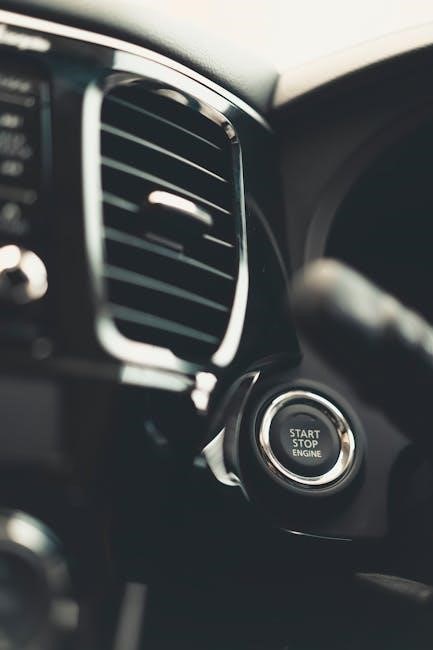The Mopar Electronic Ignition Conversion is a popular upgrade for classic vehicles, replacing outdated points-based systems with modern electronic components for improved performance and reliability.
What is Mopar Electronic Ignition Conversion?
Mopar Electronic Ignition Conversion is a process where the traditional points-based ignition system in classic Mopar vehicles is replaced with a modern electronic system. This upgrade involves installing a new distributor, electronic control unit (ECU), wiring harness, and ballast resistor to improve spark consistency and reliability. The conversion eliminates mechanical points, reducing wear and tear, and provides a hotter, more consistent spark for better engine performance. It is designed as a direct replacement for the original ignition system, ensuring compatibility with various Mopar engines. The kit includes all necessary components and instructions for a straightforward installation, making it a popular choice for restoring and enhancing the performance of classic Mopar vehicles. This conversion is ideal for those seeking a reliable, high-performance ignition system while maintaining the classic look and feel of their vehicle.
Benefits of Upgrading to Electronic Ignition
Upgrading to a Mopar Electronic Ignition system offers numerous benefits, including improved reliability, increased fuel efficiency, and enhanced engine performance. The electronic system eliminates the mechanical points, which are prone to wear and failure, reducing the need for frequent adjustments and replacements. This results in a more consistent spark, which translates to smoother engine operation, better idle, and increased horsepower. Additionally, the electronic ignition system provides better resistance to heat and engine vibrations, ensuring durability in harsh conditions. The hotter spark also improves combustion efficiency, leading to better fuel economy and reduced emissions. Overall, the upgrade is a cost-effective way to modernize a classic vehicle, ensuring it runs like new while maintaining its original character and appeal.

Preparation for the Conversion
Preparation involves gathering tools, understanding the original ignition system, and disconnecting the battery to ensure a safe and smooth electronic ignition conversion process.

Tools and Materials Required
To successfully complete the Mopar electronic ignition conversion, you’ll need specific tools and materials. Essential tools include a distributor wrench, timing light, and a 3/32 Allen wrench for adjustments. Materials required are a new electronic distributor, an electronic control unit (ECU), a wiring harness, a ballast resistor, and a high-performance ignition coil. Ensure all components are compatible with your vehicle’s make and model. Refer to the installation manual for exact specifications. Additional items like spark plug wires and a capacitor may be necessary, depending on your setup. Always use genuine Mopar parts or high-quality aftermarket alternatives to avoid compatibility issues. Proper preparation and having all parts ready will streamline the conversion process and minimize downtime. Double-check the kit contents and consult the instructions before starting for a seamless installation.
Understanding the Original Ignition System
The original Mopar ignition system relies on a points-based distributor, which generates sparks to ignite the fuel-air mixture. Points open and close to interrupt the primary circuit, creating a high voltage in the ignition coil. Over time, wear on the points can lead to inconsistent spark timing and reduced engine performance. Additionally, the system often includes a ballast resistor to regulate coil voltage and a vacuum advance for timing adjustments under varying engine loads. Understanding how these components interact is crucial for a successful electronic conversion. The points system, while reliable in its time, lacks the precision and durability of modern electronic ignition systems, which eliminate moving parts and provide a more consistent spark. Familiarizing yourself with the original setup ensures a smoother transition to the upgraded electronic system. This knowledge also helps identify potential areas for improvement during the conversion process.

Installation Instructions
Begin by disconnecting the battery to ensure safety. Remove the old distributor and install the new electronic one, aligning the rotor properly. Connect the wiring harness to the ECU and ensure the ballast resistor is correctly installed for proper voltage regulation. Follow the step-by-step guide carefully to avoid electrical issues and ensure a smooth conversion. Always refer to the provided instructions for specific wiring and component connections.
Step 1: Disconnect the Battery
Before starting the installation, always disconnect the negative battery terminal to ensure your safety and prevent any accidental electrical discharges or short circuits. Locate the battery, typically found in the engine compartment, and identify the negative (-) terminal, usually marked with a black cable or a negative sign. Use an appropriate wrench or pliers to loosen the nut on the terminal clamp. Carefully lift the clamp and pull the cable away from the terminal. This step is crucial to protect both you and the new electronic components from potential damage. Once disconnected, verify that all electrical systems are powered down before proceeding with the conversion. This precaution ensures a safe working environment and prevents any unintended sparks or power surges during the installation process.
Step 2: Remove the Old Distributor
To remove the old distributor, start by marking the distributor cap wires with their respective spark plug wire positions using a marker or labels. This ensures proper reconnection later. Next, disconnect the wires from the distributor cap and the ignition coil. Locate the distributor hold-down bolt, typically found at the base of the distributor, and loosen it using a wrench or socket. Once loosened, carefully pull the distributor straight out of the engine. Be cautious, as the distributor may be slightly stuck due to years of use. If it doesn’t come out easily, gently rock it back and forth while pulling. Once removed, inspect the area for any remaining debris or old gasket material, which should be cleaned before installing the new electronic distributor. Proper removal ensures a smooth transition to the new electronic ignition system.
Step 3: Install the New Electronic Distributor
Installing the new electronic distributor begins with aligning the distributor shaft with the engine’s camshaft. Gently insert the distributor into the engine, ensuring it seats properly without forcing it. Once aligned, tighten the hold-down bolt securely but avoid over-tightening, which could damage the distributor or engine. Reconnect the ignition coil wire and ensure all spark plug wires are securely attached to the distributor cap in their correct order, as marked during removal. Double-check the wiring connections to the electronic control unit (ECU) and ensure the distributor is properly grounded. If your kit includes a vacuum advance, connect it to the appropriate port on the intake manifold. Finally, verify the distributor’s rotational position using a timing light to ensure accurate ignition timing. Proper installation is crucial for optimal engine performance and reliable operation. Always refer to the manufacturer’s instructions for specific torque specifications and wiring diagrams.
Step 4: Mounting the Electronic Control Unit (ECU)
Mounting the Electronic Control Unit (ECU) is a critical step in the Mopar electronic ignition conversion. Choose a location that is protected from heat, moisture, and vibrations, such as under the dashboard or on a stable frame. Use the provided mounting hardware to secure the ECU firmly in place. Ensure the unit is grounded properly by connecting the ground wire to a clean, bare metal surface on the vehicle’s chassis. Avoid grounding through painted or rusty surfaces, as this can lead to poor electrical connections. Once mounted, connect the wiring harness to the ECU, following the instructions provided with the conversion kit. Double-check all connections for tightness and integrity. The ECU should be positioned away from other high-voltage components, such as the ignition coil, to prevent interference. Proper mounting ensures reliable operation of the electronic ignition system. Always refer to the manufacturer’s guidelines for specific installation recommendations.
Step 5: Connecting the Wiring Harness
Connecting the wiring harness is a straightforward process that requires careful attention to detail. Begin by locating the wiring harness and identifying the various connectors and wires included in the kit. Refer to the wiring diagram provided with your Mopar electronic ignition conversion kit to ensure proper connections. Connect the ignition switch wire to the appropriate terminal on the electronic control unit (ECU), typically marked as the “IGN” or “INPUT” terminal. Next, connect the distributor wire to the ECU, ensuring it is securely attached to the “DISTRIBUTOR” or “TRIGGER” terminal. The coil wire should be connected to the “COIL” terminal on the ECU. Finally, connect the ballast resistor wire to the “BALLAST” terminal, if applicable. Double-check all connections for tightness and consult the wiring diagram to verify accuracy. Proper wiring ensures reliable operation of the electronic ignition system. Always test the connections with a multimeter before starting the engine to avoid any issues. If unsure, consult a professional or the manufacturer’s instructions for clarification. This step is critical for the system to function correctly, so take your time and ensure everything is connected properly. By following these steps, you can ensure a successful and reliable electronic ignition conversion for your Mopar vehicle.
Step 6: Installing the Ballast Resistor
Installing the ballast resistor is a crucial step in the electronic ignition conversion process. The ballast resistor helps regulate the voltage supplied to the ignition coil, ensuring proper spark energy and preventing overheating. Locate a suitable mounting point for the resistor, preferably on the firewall or a metal surface away from heat sources. Use the provided hardware to secure the resistor firmly in place. Connect the resistor’s input wire to the ignition switch’s “start” terminal, as specified in the wiring diagram. The output wire should be connected to the ignition coil’s positive terminal. Ensure all connections are clean and free of corrosion for optimal conductivity. Tighten all bolts and wires securely to avoid any loose connections. Finally, verify the resistor’s polarity and wiring configuration with the kit’s instructions to prevent damage to the system. Proper installation of the ballast resistor is essential for reliable ignition system performance. This ensures a consistent spark, which is vital for engine operation. Always refer to the manufacturer’s guidelines for specific wiring instructions, as incorrect installation can lead to system failure or reduced performance. By carefully following these steps, you can ensure the ballast resistor functions correctly, supporting the overall efficiency of your electronic ignition system. If unsure, consulting a professional or the kit’s manual is recommended to avoid any potential issues. This step completes a critical component of the ignition system upgrade, contributing to improved engine reliability and performance.

Wiring Diagram and Connections
The wiring diagram provides a detailed guide for connecting components like the ignition switch, coil, and ballast resistor. Follow the manufacturer’s instructions for accurate connections and test wiring thoroughly.
Understanding the Wiring Diagram
The wiring diagram is a critical tool for ensuring proper installation of the Mopar electronic ignition system. It illustrates the connections between components like the ignition switch, distributor, electronic control unit (ECU), coil, and ballast resistor. Each wire is color-coded to simplify identification and installation. The diagram also shows the flow of power and signals, ensuring the system operates efficiently and safely.

By carefully following the wiring diagram, you can avoid common issues such as misconnected wires or incorrect voltage supply. It’s essential to verify each connection against the diagram before powering up the system. Additionally, use a test light to trace circuits and confirm proper grounding. This step-by-step approach ensures a reliable and high-performance ignition system.
Connecting the Ignition Switch
Connecting the ignition switch is a key step in the Mopar electronic ignition conversion. The ignition switch provides power to the system in both the “start” and “run” positions. Locate the ignition switch wiring harness and identify the “start” and “run” wires, typically marked or color-coded for clarity;
Use a test light to verify the correct wires by testing continuity from the ignition switch to the ballast resistor. Connect the “start” wire to one terminal of the ballast resistor and the “run” wire to the other. Ensure all connections are secure and properly insulated to prevent electrical interference or short circuits. This setup ensures proper power delivery to the electronic ignition components, enabling reliable engine starting and operation.
Connecting the Coil and Ballast Resistor

Connecting the coil and ballast resistor is essential for proper electronic ignition functionality. Begin by mounting the ballast resistor securely, ensuring it is properly grounded to prevent interference. Next, locate the ignition coil and connect its positive terminal to the output terminal of the ballast resistor using the provided wiring harness.
The negative terminal of the ignition coil should be connected to the distributor cap. Ensure all connections are tight and free from corrosion to maintain optimal performance. Refer to the wiring diagram for specific connections, as improper wiring can lead to system malfunction. Proper installation ensures a consistent spark, improving engine performance and fuel efficiency. Always use the resistor specified in the kit to avoid damage to the electronic components. This step is critical for achieving a reliable and high-performance ignition system.
Testing the Wiring Connections
Testing the wiring connections is a critical step to ensure the electronic ignition system operates correctly. Start by visually inspecting all wires and connections for damage or corrosion. Use a multimeter to verify continuity and resistance, aligning with the specifications provided in the kit. Check the ignition switch connections to confirm proper power supply to the coil and distributor. Test the wiring with the ignition in different positions (OFF, RUN, START) to ensure correct functionality. If a short circuit is suspected, isolate and test each wire individually. After confirming all connections are correct, start the engine to verify smooth operation. Proper testing ensures reliable ignition performance and prevents future issues. This step is crucial for a successful Mopar electronic ignition conversion; Always refer to the wiring diagram for accurate testing procedures. Ensure all components are securely connected for optimal performance.

Troubleshooting Common Issues
Frequent issues include no-spark conditions, erratic timing, and faulty components. Check the ECU, wiring harness, and ballast resistor for damage or poor connections. Verify spark plug wires and ignition coil functionality. Ensure proper grounding and consult the wiring diagram for accurate diagnostics.
Identifying Faulty Components
Identifying faulty components is crucial for troubleshooting the Mopar electronic ignition system. First, inspect the Electronic Control Unit (ECU) for signs of physical damage or corrosion. Check the wiring harness for any frayed or loose connections, as these can disrupt the system’s operation. The ballast resistor is another common culprit, as it can fail over time, leading to a weak spark. Additionally, the ignition coil should be tested for resistance using a multimeter to ensure it falls within the manufacturer’s specifications. Spark plug wires should also be examined for cracks or wear, which can cause misfires. If issues persist, consult the wiring diagram to trace connections and isolate the problem. Proper diagnostic tools, such as a test light or multimeter, are essential for accurately identifying and replacing faulty components. Regular maintenance can prevent many of these issues from arising. Always refer to the installation instructions for specific guidance on testing and replacing parts. By systematically checking each component, you can efficiently diagnose and resolve problems with your Mopar electronic ignition conversion.
Resolving No-Spark Conditions

A no-spark condition is a common issue after an electronic ignition conversion. Start by checking the battery and ignition switch for proper function. Ensure all connections are clean and secure, as corrosion or loose wires can prevent spark. Test the Electronic Control Unit (ECU) by verifying its power supply and ground connections. If the ECU fails, replace it with a compatible unit. Inspect the distributor cap and rotor for wear or cracks, as these can disrupt the spark path. Use a test light to check for voltage at the coil and ballast resistor, ensuring they are functioning within specifications. If the ballast resistor is faulty, replace it with the one provided in the conversion kit. Finally, verify the spark plug wires are properly connected and not damaged. If the issue persists, consult the wiring diagram to trace the ignition circuit and identify any breaks or short circuits. Regular maintenance and thorough testing can resolve most no-spark conditions effectively. Always follow the manufacturer’s instructions for testing and replacement procedures. By systematically diagnosing each component, you can restore spark and get your engine running smoothly. Proper tools, such as a multimeter, are essential for accurate diagnosis. If unsure, consult a professional mechanic or refer to the troubleshooting guide provided with the conversion kit. Ensuring all components are functioning correctly will help prevent future no-spark issues and maintain reliable engine performance.
Fixing Erratic Ignition Timing
Erratic ignition timing can cause poor engine performance and misfires. Start by checking the distributor’s installation, ensuring it’s properly seated and aligned with the engine’s timing marks. Verify the distributor cap and rotor for wear or cracks, replacing them if necessary. Inspect the spark plug wires for damage or resistance issues, as faulty wires can disrupt timing. Use a timing light to check the ignition timing against the specifications in the conversion kit manual. If the timing is off, adjust the distributor according to the manufacturer’s instructions. Ensure the Electronic Control Unit (ECU) is correctly calibrated and mounted securely, as loose connections or incorrect calibration can cause timing irregularities. Check the wiring harness for any signs of damage or interference, as this can affect signal accuracy. If issues persist, consider consulting a professional or the troubleshooting guide provided with the conversion kit. Proper alignment and calibration are key to maintaining consistent ignition timing and optimal engine performance. Regular maintenance, such as replacing worn components and verifying connections, can help prevent future timing issues. Always follow the recommended procedures for your specific Mopar electronic ignition system to ensure reliability and efficiency. By addressing each potential cause systematically, you can restore accurate ignition timing and achieve smoother engine operation.

Maintenance and Upgrades
Regularly inspect and replace worn components like spark plugs and wires. Upgrade to high-performance coils or capacitive discharge systems for improved reliability and efficiency in your Mopar ignition system.
Regular Maintenance Tips
Regular maintenance is crucial to ensure the longevity and optimal performance of your Mopar electronic ignition system. Start by inspecting the ignition coil and spark plug wires for wear or damage. Replace any corroded or cracked components immediately. Check the distributor cap and rotor for dust or debris, cleaning them gently with a soft brush if necessary. Ensure all electrical connections are secure and free from corrosion. Spark plugs should be replaced every 30,000 to 50,000 miles, depending on your vehicle’s specifications. Additionally, monitor the battery health, as a weak battery can disrupt the electronic ignition system. Finally, refer to your owner’s manual for specific maintenance schedules tailored to your Mopar vehicle.
Upgrading to High-Performance Components
Upgrading to high-performance components can significantly enhance your Mopar electronic ignition system’s efficiency and power output. Consider installing a high-output ignition coil, which provides a hotter spark for better combustion. Spark plug wires with higher resistance, such as those made from silicone or magnesium, can reduce energy loss and improve spark delivery. Additionally, upgrading to a performance-grade distributor cap and rotor ensures consistent spark distribution under high RPM conditions. For maximum performance, pair your electronic ignition system with a high-performance air filter and fuel intake system. These upgrades not only boost horsepower and torque but also ensure reliable operation during extreme driving conditions. Always follow the manufacturer’s instructions and ensure compatibility with your vehicle’s specific make and model.
Calibrating the Electronic Ignition System
Calibrating the electronic ignition system ensures optimal performance and proper timing. Start by setting the ignition timing using a timing light, following the manufacturer’s specifications. Adjust the distributor as needed to achieve the correct advance curve. Fine-tune the electronic control unit (ECU) settings, if applicable, to match your vehicle’s specific requirements. For vehicles with adjustable spark advance, modify the settings to improve idle stability and high-RPM performance. Use a wiring diagram to verify all connections are correct and functioning properly. Test the system under various driving conditions to ensure consistent spark delivery. If equipped, utilize a scan tool or diagnostic software to monitor and adjust the ignition system for maximum efficiency. Proper calibration enhances fuel efficiency, reduces emissions, and improves overall engine responsiveness, making it a critical step in the electronic ignition conversion process.
